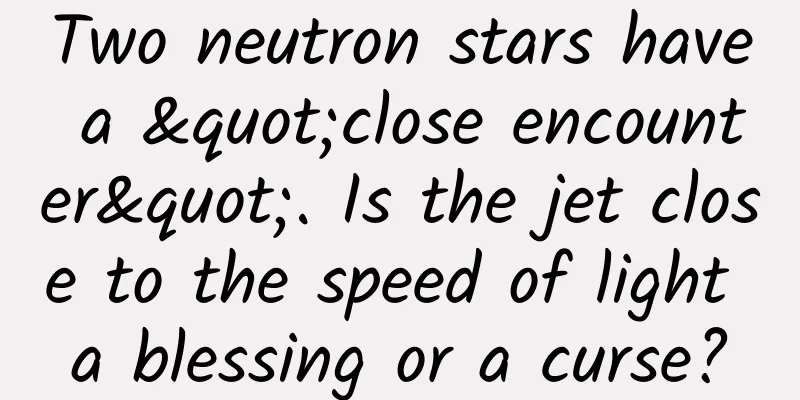Two neutron stars have a "close encounter". Is the jet close to the speed of light a blessing or a curse?

|
Hubble shows neutron star collision jets travel at nearly the speed of light In August 2017, astronomers observed a rare explosion when two ultra-compact neutron stars collided head-on, releasing an extremely powerful jet of radiation. Two days later, Hubble began observing the jet. Astronomers detected gravitational waves from a neutron star for the first time during that explosion. Now, five years later, scientists have finally been able to measure the speed of that radiation stream. "The results show that the speed of the jet at the beginning of launch was 99.97% of the speed of light," said Wenbin Lu from the University of California, Berkeley, who was responsible for data interpretation, in a report. An artist's illustration of a neutron star collision. (Image credit: Elizabeth Wheatley (STScI)) An artist's interpretation of a collision between two neutron stars. (Image credit: Elizabeth Wheatley (STScI)) Scientists called the event GW170817, and it was initially detected through gravitational waves and gamma rays produced by the explosion. These signals were captured by 70 observatories in Earth and near-Earth orbit, including Hubble. The data showed that the collision of these ultra-compact neutron stars was enough to create a black hole and an explosion with a total energy release comparable to a supernova. As the newborn black hole grows, it begins to draw surrounding matter into a vortex disk, which then ejects matter from the center in two directions - this is the cause of the jets observed by Hubble. To calculate the speed of the jet, scientists specifically observed the movement of a small group of explosion debris, which was carried into space by the jet. "The determination of the trajectory of the debris requires extremely high data accuracy, equivalent to measuring the diameter of a 12-inch pizza on the moon from Earth. These high-precision data were collected by Hubble and some radio telescopes," NASA officials wrote in a report. This is difficult because the jet is coming directly at Earth, which makes it appear to be traveling much faster than the speed of light, which is 4 or 7 times faster than light. "I was surprised at how accurate the Hubble measurements were, even comparable to the powerful Very Long Baseline Interferometry radio telescopes that are spread all over the world," said Kunal P. Murray of Caltech, lead author of a new paper on the research. It took scientists five years to find a method powerful enough to analyze the event. It was a long time, but it was worth it. Now scientists have more methods to choose from to analyze the merger of neutron stars. More specifically, they can further study gravitational waves, which will help to accurately measure the expansion rate of the universe in the future. Muhly's paper was successfully published in the journal Nature on Wednesday (October 13). Related knowledge A neutron star is the collapsed core of a supergiant star. Supergiants have masses between 10 and 25 times that of our sun, and can be much more if they are rich in metals. Aside from black holes and some hypothetical objects such as white holes, quark stars, and strange stars, neutron stars are the smallest and densest class of objects known. A neutron star has a radius of about 10 kilometers (6 miles) and can weigh up to 1.4 times the mass of our sun. They form when a giant star explodes as a supernova, accompanied by gravitational collapse. In this process, the core of the star is compressed, and its density exceeds that of a white dwarf, eventually reaching the density of an atomic nucleus. The Hubble Space Telescope is a space telescope that was launched into low-Earth orbit in 1990 and is still in operation. Hubble was not the first space telescope, but it is one of the largest and most versatile, making it a powerful scientific tool and a astronomical blessing for the general public. The Hubble Space Telescope is a major NASA observatory named after astronomer Edwin Hubble. The Space Telescope Science Institute selects Hubble's observation objects and processes the collected data, while the Godard Space Flight Center operates the space shuttle. A black hole is a quasar that is like an ideal black body. It does not reflect light[6][7] and has such a strong gravitational pull that it forms a region from which all particles and electromagnetic radiation, such as light, cannot escape[8]. General relativity predicts that sufficiently compact masses can warp spacetime to form a black hole[9][10]; the boundary of the region beyond which escape is impossible is called the event horizon. Although the event horizon has a profound effect on the fate and behavior of objects that cross it, observations of the region do not appear to detect any signatures.[11] Furthermore, quantum field theory in curved spacetime predicts that the event horizon emits Hawking radiation, which, like the spectrum of a black body, can be used to measure a temperature inversely proportional to its mass. For black holes of stellar mass, this temperature is typically on the order of a few billionths of a kelvin and is therefore essentially unobservable. BY:Stefanie Waldek FY: taokesasi If there is any infringement of related content, please contact the author to delete it after the work is published. Please obtain authorization for reprinting, and pay attention to maintaining integrity and indicating the source |
<<: Why do I feel so tired even though I just sit all day at work?
Recommend
Tips for cold-starting short video community content!
The short video community is dominated by content...
Android Data Binding
1. Basic structure 1.1 JavaBeans Objects public c...
To protect your liver and avoid making mistakes, stop eating these 4 kinds of food!
Modern people work, study and play games every da...
How long does it usually take to review a WeChat Mini Program? How many days does it take for a WeChat mini program to be approved?
How long does it usually take to review a WeChat ...
Major changes in advertising and marketing strategies over the past century!
On the day JWT was merged with digital marketing ...
Can a computer write perfect pop music?
The Atlantic Monthly recently published an articl...
To improve the conversion rate of promotion landing pages, there are five essential elements...
The landing page is the first impression that con...
Why is it that the rocket is fine when it flies out, but the spacecraft burns up when it comes back? The key is speed
The process of a rocket igniting and taking off f...
11 dams blocked the century-old flood. The city built by "Zhejiang people" 5,000 years ago was so powerful!
More than 5,000 years ago, the wise Liangzhu peop...
Failed Mathematics! It turns out AI is also a student with a weak academic performance...
It's the time for the college entrance examin...
The three parties jointly built the Tianjin Automobile Base, and Dong Mingzhu made every step carefully in car manufacturing
Although Gree's acquisition of Zhuhai Yinlong...
Fast charging vs flash charging! What is the difference between the two charging methods? Finally figured it out
As mobile phones become more and more powerful Ev...
Osmanthus flowers in Zhejiang bloomed in March? Experts: They may have been "tricked" by the temperature
In March, some netizens discovered that osmanthus...
The historical origin and implementation principle of CFArray
In iOS development, NSArray is a very important d...
Why are we building a telescope in Antarctica?
Please watch a "joyful" video first. Yo...









